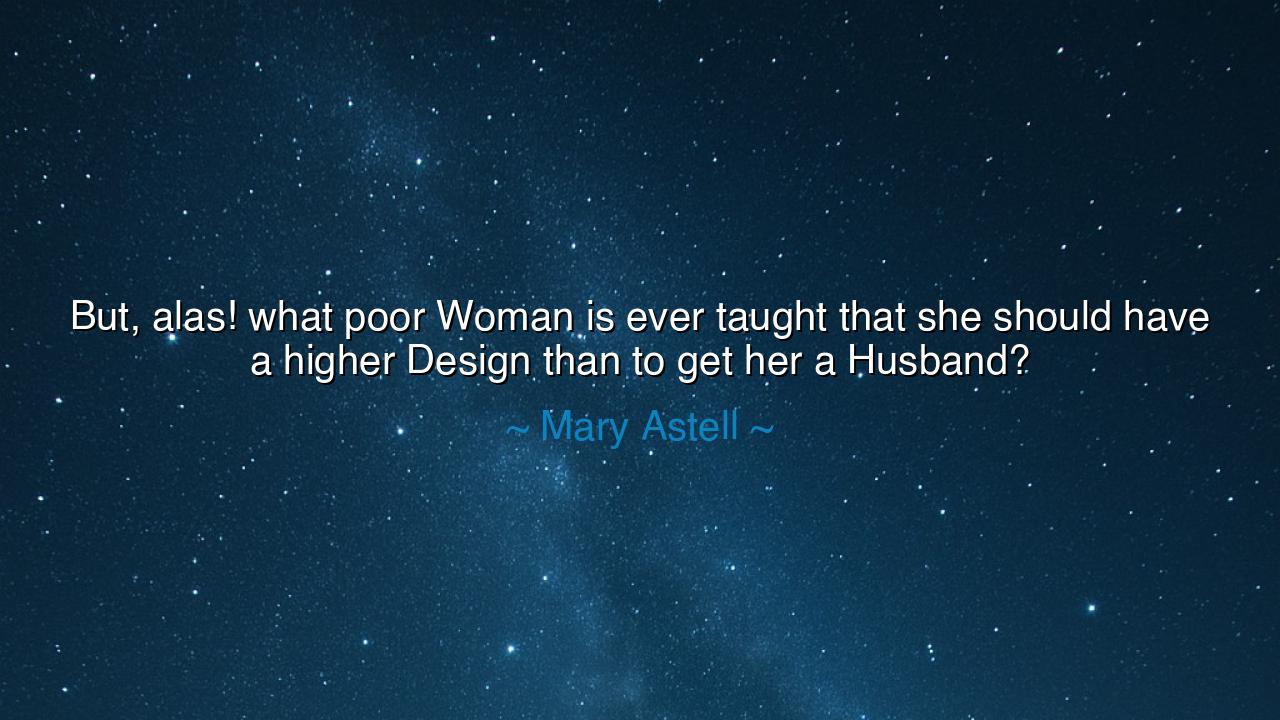
But, alas! what poor Woman is ever taught that she should have a
But, alas! what poor Woman is ever taught that she should have a higher Design than to get her a Husband?






Mary Astell, a voice of fierce intellect in an age that silenced women, once asked with both sorrow and defiance: “But, alas! what poor Woman is ever taught that she should have a higher Design than to get her a Husband?” In this piercing question lies the cry of centuries — the lament of countless souls whose talents were confined, whose minds were dimmed by custom, and whose destinies were written for them by others. Her words are not the complaint of a single woman, but the awakening of half the human race. It is a call to purpose, to education, to the divine potential of the feminine spirit that has too long been caged within the narrow bounds of expectation.
The meaning of her words strikes at the very heart of social conditioning. Astell is not condemning marriage itself, but the limitation of ambition — the way society taught women to see the securing of a husband as their highest triumph, and the measure of their worth. To her, this was a tragedy of design — not of nature. Women, she argued, were born with minds as capable of reason and virtue as men, yet they were denied the education to cultivate them. Their spirits, which could soar to philosophy, poetry, science, or governance, were instead tethered to the domestic and the ornamental. Her cry of “what poor Woman is ever taught” was not a statement of despair, but a summons to awakening — a call for women to know that their design, their purpose, could and must be higher.
The origin of this quote can be traced to Astell’s groundbreaking work, A Serious Proposal to the Ladies (1694), one of the earliest manifestos for women’s education and intellectual independence. Living in England during the late seventeenth century — an era ruled by men in pulpit, parliament, and press — Astell dared to imagine a world where women were educated not merely to please, but to think, to reason, to govern their own lives. Her vision was revolutionary: she proposed the creation of an academy for women, a spiritual and intellectual retreat where they might learn philosophy, theology, languages, and science — pursuits then considered beyond a woman’s capacity or duty. Her question, then, was not rhetorical, but a challenge: Why should the mind of woman be denied the right to seek truth, simply because her body is born to a different form?
To understand her words more deeply, we might recall the story of Hypatia of Alexandria, the philosopher and mathematician of ancient times. In an age when few women could read, she taught astronomy and philosophy to scholars from every corner of the ancient world. Yet her brilliance was met not with honor, but with fear and violence — she was murdered by those who could not bear the sight of a woman thinking freely. Centuries later, Mary Astell inherited the same struggle in gentler guise: not the threat of the mob, but the suffocating gentility of expectation, which declared that a woman’s glory lay not in wisdom, but in obedience. Both Hypatia and Astell stand as symbols of the eternal war between the soul’s desire to rise and society’s demand to kneel.
Astell’s lament also speaks to the inner life — to the way the human spirit withers when it is denied its purpose. To live without a “higher design,” she warns, is to live as an echo rather than a voice. The woman who is taught only to seek approval, only to marry well, becomes alienated from the grandeur of her own potential. Yet, when she is allowed to cultivate her mind, she becomes a beacon not only for herself, but for all humanity. For in truth, when the intellect of half the world is restrained, the progress of the whole world is halted. The elevation of woman is not the defeat of man; it is the completion of mankind.
But even as Astell spoke in her own time, her words still reverberate in ours. How many, even now, are taught to measure worth by validation, rather than by vision? How many are still told that beauty is their crown and not wisdom, not character, not courage? The question she asked over three centuries ago is not yet fully answered. Yet her defiance lit the path for those who would follow — for Mary Wollstonecraft, for Sojourner Truth, for Malala Yousafzai, and for every voice that has dared to say: “My design is higher.”
The lesson, then, is as clear as dawn. Every soul, whether woman or man, must seek its higher design — that purpose beyond survival or approval, beyond comfort or conformity. Learn, not because you are told to, but because wisdom is freedom. Create, not because you must, but because creation is the breath of the divine within you. And never let the boundaries of your time determine the boundaries of your mind. As Mary Astell taught, destiny is not inherited — it is designed, and it is earned through the courage to think, to aspire, and to act.
So, remember her words, children of the future: “What poor Woman is ever taught that she should have a higher Design than to get her a Husband?” Let no one, in any age, reduce your worth to what you serve, or whom you please. Seek a higher design — a purpose worthy of your intellect and your soul. For the measure of a life is not whom it wins, but what it builds, and whom it frees.






AAdministratorAdministrator
Welcome, honored guests. Please leave a comment, we will respond soon